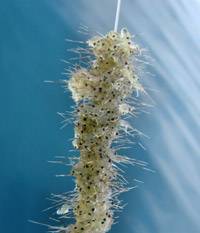Scientists and LCC Call for Canal Closure

Spiny waterfleas accumulate on fishing line. Photo from Minnesota Sea Grant.
Earlier this month the spiny waterflea was confirmed in the Champlain Canal and the Glens Falls feeder canal. The spiny waterflea is an invasive plankton species native to Eurasia. The Champlain Canal is directly connected to Lake Champlain in Whitehall, so this invasive is now at our doorstep and, without immediate action, could soon enter the lake.
The Lake Champlain Committee, along with a host of scientists and lake advocates, has signed onto a letter urging the Canal Corps to close the gates at the top of the Feeder Canal in Glens Falls and halt boat traffic between Lock 9 (at the height of land between the Champlain and Hudson drainage) and Lake Champlain. The letter notes, “Significant ecological impact has been seen in Lake Ontario and the Great lakes, Canadian shield lakes and fishing industries in the entire Great Lakes region. The inconvenience to a very small number of boaters is worth it to save a multi-million dollar economic resource.”
The Champlain Canal has been the route by which many of Lake Champlain’s invasive species have arrived including zebra mussels, white perch, Eurasian water milfoil, and water chestnut. According to the Burlington Free Press, the lock closest to Lake Champlain served fewer than 1,100 boats last summer, 90 percent of them pleasure craft.
LCC recognizes that canal closure would temporarily disrupt recreational boat traffic. However, we believe the action is necessary to give resource managers a chance to clearly assess the threat presented by the spiny waterflea and the available options to keep it out of Lake Champlain. Once the spiny waterflea reaches the lake there are no options for control.
Spiny waterfleas’ presence in Lake Champlain would likely disrupt the middle of the food web. They feed on smaller plankton. Meanwhile, small fish have difficulty feeding on the species because of their large spine, though larger fish apparently can eat them. The presence of the animal in the lake may shift abundances of desirable fish species. They are a nuisance to anglers as their long tail spines hook on fishing line and foul gear.
Spiny waterfleas likely entered the canals from the Great Sacandaga Reservoir where they have been found since 2008. They were first detected in North America in Lake Huron in 1984. By 1987 they had spread to all of the Great Lakes.
For years there have been calls for the New York State Canal Corps to take concrete steps to limit the possibility of invasive species spread between the Hudson River system and the Lake Champlain system. A 2005 report titled Feasibility of Champlain Canal Aquatic Nuisance Species Barrier Options spurred the discussion. At a public meeting in 2008 the Canal Corps heard from numerous voices including the Lake Champlain Committee about the important role the canal played as a vector for invasive species.
We need to send a message to the Canal Corp that their efforts to date to address invasive species are insufficient. While the Canal Corp has been willing to consider educating boaters about the risk of spreading invasive species, when it actually comes to preventing species passage they have done nothing. If this invasive establishes in Lake Champlain the Canal Corps intransigence will rightfully be seen as a direct cause of the irrevocable alteration of the Lake Champlain ecosystem.
Please contact the New York State Canal Corps and urge them to take whatever means necessary to prevent the spread of invasive species in the canal system.
